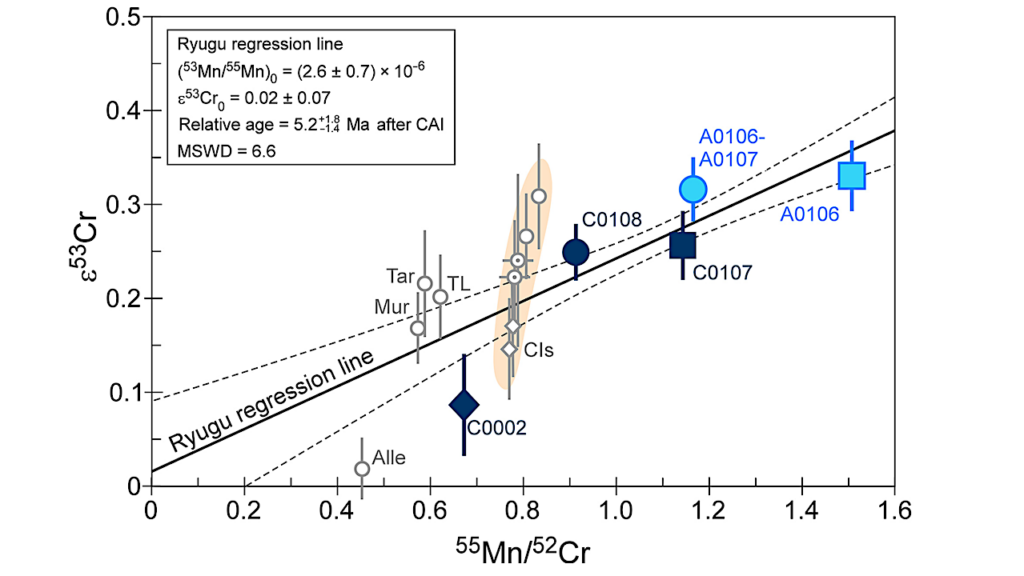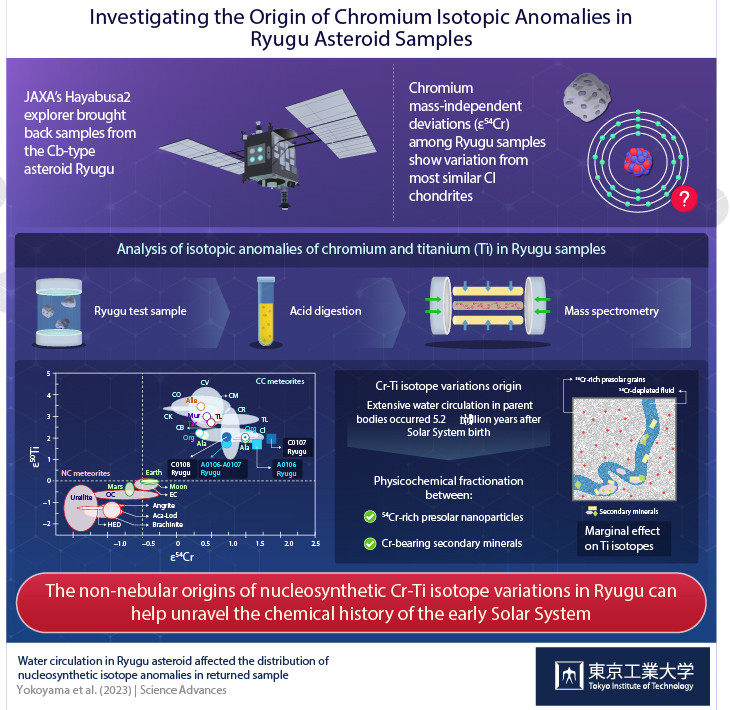Exploring The Origin Of Nucleosynthetic Isotope Variations In Ryugu Samples

The Hayabusa2 space mission by the Japan Aerospace Exploration Agency (JAXA) returned home with samples of the asteroid Ryugu that orbits the Sun between Earth and Mars.
Preliminary chemical analysis of Ryugu samples revealed that the asteroid is rich in volatile and organic-rich materials, which shows similarities to the class of meteorites known as Ivuna-type carbonaceous chondrites (CIs). Such asteroids have gained the attention of scientists due to their close chemical resemblance with elemental environments during the birth of the solar system.

Studies have shown that isotopic anomalies in chromium (54Cr/52Cr) and titanium ratios (50Ti/47Ti), often expressed as ε54Cr and ε50Ti, respectively, can help decipher the nucleosynthetic origins of chemical components in extraterrestrial materials. While the isotopic variability of other elements in bulk Ryugu samples is similar to that in CIs, anomalies in Cr isotopes are slightly different from those recorded in the literature. To unravel the origin of these deviations, an international team of scientists led by Professor Tetsuya Yokoyama from Tokyo Institute of Technology has recently investigated ε54Cr and ε50Ti in five different Ryugu samples. Their results have been published in Scientific Advances.
“Prior studies on the asteroid samples established that Ryugu and Ivuna-type carbonaceous chondrites were born in a common place; more distant part of the solar system than other meteorite parent bodies. However, the slight discrepancy in isotopic anomalies of Cr between Ryugu and CIs gave rise to the question whether the heterogeneity is due to the difference in the birth place, or did it arise from secondary processes that occurred after the accretion of their parent bodies,” explains Prof. Yokoyama.
For precise analysis of the Cr and Ti anomalies, the team selected two Ryugu samples from the first touchdown and three from the second touchdown site. The samples were first digested in acids and subjected to inductively coupled plasma mass spectrometry (ICP-MS) and thermal ionization mass spectrometry (TIMS). The test results in samples weighing less than 24 milligrams indicated that the variation in ε50Ti is marginal and agrees with the data available on CIs. The same was not true for ε54Cr values, where the dispersions exceeded formerly reported values for CIs. However, when the sample was greater than 90 milligrams, isotopic similarity was found. This observation suggested that Cr isotopes are not uniformly distributed in the Ryugu parent body at the microscopic level, while Ryugu has a Cr isotopic composition similar to CIs at the macroscopic level, thus corroborating the idea that Ryugu and CIs share a common genetic heritage.

The non-nebular origins of nucleosynthetic Cr-Ti isotope variations in Ryugu can help unravel the chemical history of the early Solar System. CREDIT Tokyo Tech (Revised)
Further analysis of the samples indicated that the microscopic heterogeneity in Cr isotope distribution arose from the physicochemical fractionation of 54Cr-rich presolar nanoparticles and Cr-bearing secondary minerals. This phenomenon was attributed to the aqueous alteration within the asteroid. The water in the asteroid dissolved the mildly soluble Cr while 54Cr-rich presolar nanoparticles undissolved, circulated the 54Cr-depleted fluid within the body, resulting in the precipitation of secondary minerals depleted in 54Cr. This scenario was supported by the analysis of radiogenic isotope 53Cr carried out by the team, which revealed that the precipitation of secondary minerals occurred around 5.2 million years after the birth of the solar system.
Nucleosynthetic 54Cr anomalies in extraterrestrial materials are often connected to their nebular origins, but this study reveals that apparent 54Cr variabilities in asteroidal materials could also rise from parent body processes such as elemental redistribution by water.
“Unlike meteorites that plummet to earth from space, Ryugu samples are unaffected by terrestrial contamination, and they are particularly valuable for unravelling the earliest history of the solar system as they retain primitive chemical characteristics. Therefore, this study is a step closer to fully understanding our chemical past,” concludes Prof. Yokoyama.
Water circulation in Ryugu asteroid affected the distribution of nucleosynthetic isotope anomalies in returned sample, Science Advances (open access)
Astrobiology, Astrochemistry,








